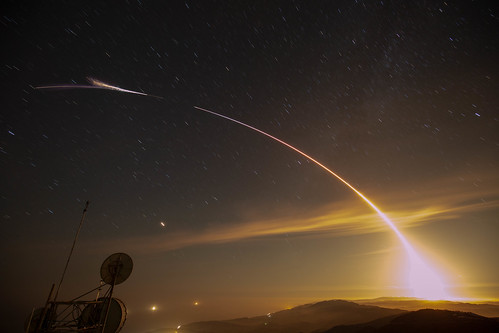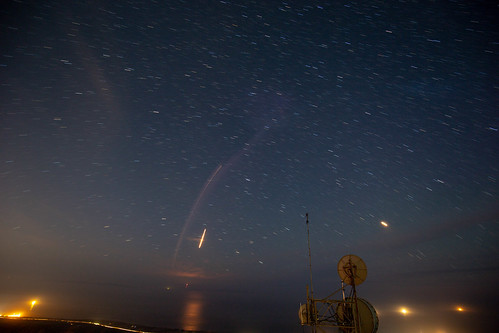[photos: flickr – SpaceX Iridium-7]
After not being able to make the Iridium-6 and NASA InSight launches I was eager to make the next launch from Vandenberg. Last night I drug along a friend and we pulled an all-nighter driving down to Lompoc and back for the SpaceX Iridium-7 launch. I’m wore out but at least I have a photo and new knowledge for next time.
Instead of viewing the launch from Ocean Ave we opted to go back up on the Santa Ynez Mountains, about 30 miles away. (Actually I swung through Lompoc at 1 AM to see if going out to Surf Beach was possible, but the road was already closed). I was barely able to pick up the 386.3 MHz Launch Net on my handheld radio, but I was not receiving several chunks of audio I expected from last time, including the final countdown which made timing the shot tricky.
The launch was at 4:39 AM, the moon had just set around 4:25 AM and it got surprisingly dark quickly. The Milky Way was just visible directly over the launch location and overhead. I was able to see the glow at ignition which allowed us to set off our shutters. After about 30 seconds into flight there was a beautiful, very bright, long blue flame that looked like a giant shooting star or comet streaking through the sky. There wasn’t any sound for the longest time, then some faint rumbling like from a distant thunderstorm that went on for a long time.
After the rocket passed out of what I estimated my lens’ view, I turned it to the south and took another long exposure. The second stage was this bright little pinprick of light gradually going to the horizon. I was surprised that I could see the boost-back and landing burns all the way down to the ocean considering how far off it was. I’m pretty sure I heard a faint sonic boom during booster re-entry as well!
So yeah, it turns out I overexposed my shots trying to bring in the Milky Way. I was able to bring it down a bit in Lightroom to a somewhat tolerable level. This made me realize other rocket trail photos I’ve seen aren’t exposed too much, because there are few stars to be seen and eliminates the star streaks. The 16-35 mm lens I had was perfect for capturing the arc at that distance until stage separation. Things to remember for next time!
As a bonus, here’s a photo I botched but still looks cool, and it’s the only one of the long flame trails that I have.
When I first saw this I was wondering what I had photographed. What was that weird offset flame? Was that a gas generator? That can’t be right, this was the first stage. After fiddling with exposure I realized I had jiggled the camera while hand holding it so much that I essentially got the flame trails from the Falcon 9 several times in the same exposure. Only one of the streaks is “real”.


